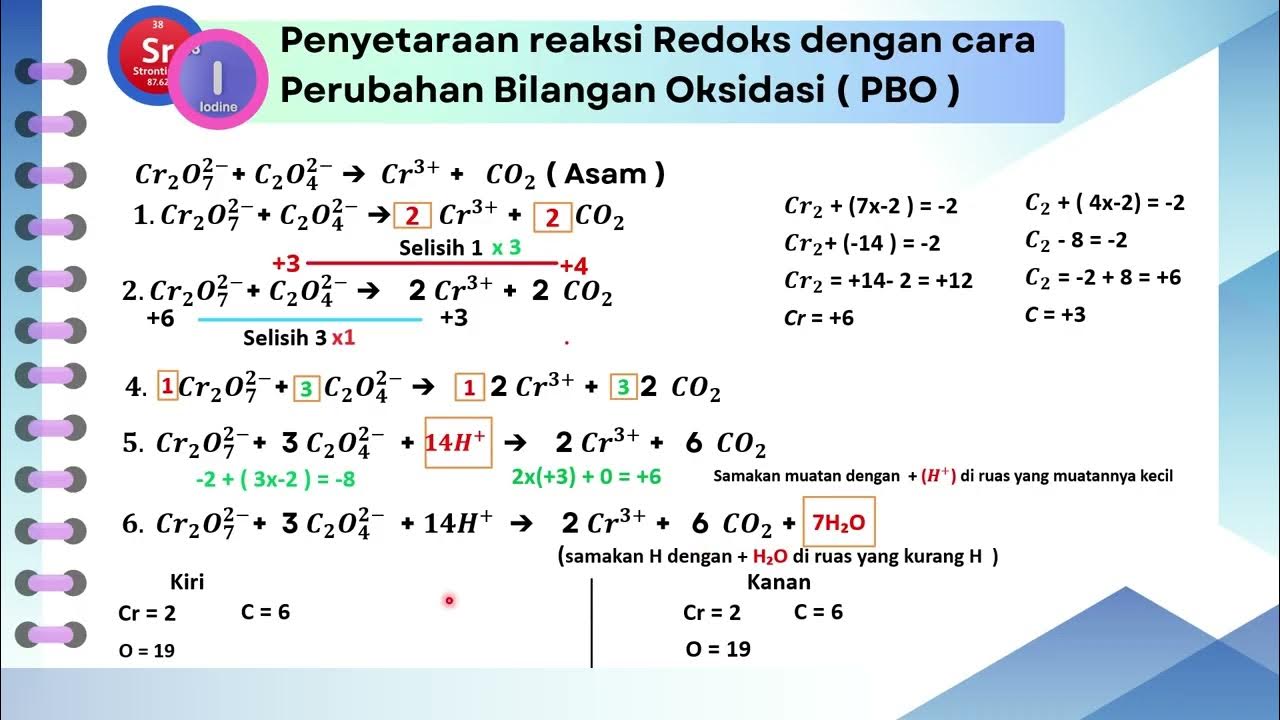Balanceo por Método REDOX (paso a paso y bien fácil)
Summary
TLDRThis video provides a step-by-step guide to balancing a chemical equation using the oxidation-reduction (redox) method. It begins by explaining how to assign oxidation states to elements, starting with hydrogen (+1) and oxygen (-2), and moves on to identifying elements that undergo oxidation and reduction. The script details the process of balancing the equation by adjusting coefficients, ensuring the number of atoms of each element is equal on both sides. The video emphasizes the importance of balance and provides a practical demonstration using an example, encouraging viewers to practice and refine their skills in balancing chemical reactions.
Takeaways
- 😀 Assign oxidation states to each element in the reaction to understand how they change during the reaction.
- 😀 Hydrogens typically have an oxidation state of +1, and oxygen generally has -2 in most compounds.
- 😀 Any uncombined element, like tin, has an oxidation state of 0.
- 😀 Identify which elements are oxidized (lose electrons) and which are reduced (gain electrons).
- 😀 Write separate half-reactions for oxidation and reduction, excluding the oxidation states.
- 😀 Balance atoms other than oxygen and hydrogen first in the half-reactions.
- 😀 Balance oxygen atoms by adding H₂O molecules and hydrogen atoms by adding H⁺ ions.
- 😀 To balance charges in the half-reactions, add electrons where needed.
- 😀 Equalize the number of electrons lost in oxidation and gained in reduction by multiplying the half-reactions appropriately.
- 😀 Combine the half-reactions and adjust the coefficients to ensure the equation is balanced for both atoms and charges.
- 😀 After combining the half-reactions, check the balance for both atom count and charge conservation on both sides.
Q & A
What is the first step in balancing a chemical equation using the method of two half-reactions?
-The first step is to assign oxidation numbers to each element in the equation, starting with hydrogen, which is assigned +1, and oxygen, which is assigned -2.
How are oxidation numbers assigned to hydrogen and oxygen in chemical equations?
-Hydrogen is assigned +1 when it is part of a compound, and oxygen is assigned -2 when it appears at the end of a formula or as part of a compound.
What is the purpose of balancing a chemical equation?
-The goal of balancing a chemical equation is to ensure that the number of atoms of each element is the same on both sides of the equation, in accordance with the law of conservation of mass.
Why is the balance of hydrogen and oxygen typically the last step in balancing a chemical equation?
-Hydrogen and oxygen are often the most challenging elements to balance because they appear in many compounds, which can complicate the balancing process. It is easier to balance other elements first before focusing on these.
What role does the oxidation number play in the method of half-reactions?
-The oxidation numbers help identify which elements are oxidized (lose electrons) and which are reduced (gain electrons), facilitating the setup of half-reactions that can be balanced separately.
What does it mean when an element is said to be oxidized in a chemical reaction?
-Oxidation refers to the process where an element loses electrons. In the script, tin (Sn) is oxidized from 0 to +4, meaning it loses electrons.
What does it mean when an element is said to be reduced in a chemical reaction?
-Reduction refers to the process where an element gains electrons. In the script, nitrogen (N) is reduced from +5 to +2, meaning it gains electrons.
How are the coefficients in a balanced chemical equation determined using the half-reaction method?
-The coefficients are determined by balancing the number of electrons transferred in the oxidation and reduction half-reactions. The coefficients must be adjusted so that the total number of electrons lost in oxidation equals the number of electrons gained in reduction.
What is the significance of the numbers written above the elements during the balancing process?
-The numbers above the elements represent their oxidation states, which are used to track changes in the elements during the reaction and help balance the equation.
How is the final balanced equation verified in the script?
-The final balanced equation is verified by checking if the number of atoms of each element is the same on both sides of the equation. For example, nitrogen, tin, hydrogen, and oxygen atoms are all counted and verified to match on both sides.
Outlines

This section is available to paid users only. Please upgrade to access this part.
Upgrade NowMindmap

This section is available to paid users only. Please upgrade to access this part.
Upgrade NowKeywords

This section is available to paid users only. Please upgrade to access this part.
Upgrade NowHighlights

This section is available to paid users only. Please upgrade to access this part.
Upgrade NowTranscripts

This section is available to paid users only. Please upgrade to access this part.
Upgrade NowBrowse More Related Video
5.0 / 5 (0 votes)





